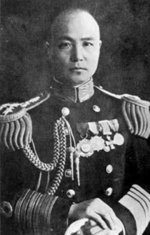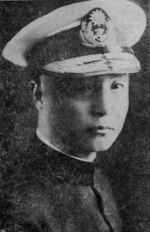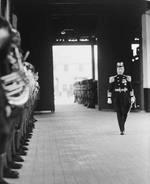Chen Shaokuan
| Surname | Chen |
| Given Name | Shaokuan |
| Born | 7 Oct 1889 |
| Died | 30 Jul 1969 |
| Country | China |
| Category | Military-Sea |
| Gender | Male |
Contributor: C. Peter Chen
ww2dbaseChen Shaokuan was born in Chengmen Village, Min County, Fujian Province, China in 1889. His father was originally a carpenter, but joined the Qing Dynasty Navy as a ordinary seaman, thus introducing him to the life at sea. At the age of 17, he attended the Jiangnan Naval Academy in Nanjing, China, graduating at the age of 20, and served aboard training cruiser Tongji. In 1910, he served as an ensign aboard training cruiser Jingqing. By 1914, he had already risen to the rank of lieutenant commander, serving with the headquarters of the navy of the newly formed Republic of China. In 1915, he was promoted to the rank of commander and was assigned to the vessel Zhaohe. In 1916, he visited the United States and Europe, and observed combat aboard British warships. In 1918, he served in France, Italy, and the United Kingdom as a naval attaché. From 1919, he supervised various Chinese seafaring and naval student groups in Paris, France and in London, England, United Kingdom. In 1921, he returned to China and took command of training cruiser Tongji. In 1923, he was named the commanding officer of light cruiser Yingrui. In 1926, he was promoted to the rank of rear admiral and was named the commanding officer of the 2nd Fleet. In Oct 1926, he declared allegiance to the forces aligned with the Nanjing-based government, seeing action in the subsequent months against varoius warlord factions within China during the Northern Expedition; he was named the head of the newly reorganized Navy Department, but he would fail to unify all naval forces which were operating independently under various warlords. In 1928, he submitted a request for 20,000,000 Yuan for the construction of China's first aircraft carrier; in 1930, he submitted a plan for the future expansion of the Chinese Navy, which in his vision would possess one aircraft carrier, two heavy cruisers, two light cruisers, 28 destroyers, 24 submarines, and 106 smaller vessels including gunboats, minesweepers, submarine tenders, and torpedo boats. He would never see enough funding to build such a large navy. In 1930, after several years of being second in command at the Navy Department, he returned to its leadership once again, while also being named the chief of the Jiangnan Dock & Engineering Works in Shanghai, China. In 1932, he was promoted to the rank of admiral and was inducted into the Nationalist Party Central Committee. Around this time, he reorganized the naval academy in Fujian Province, graduating many officers each year, some of whom educated by British naval officers hired to teach at the academy; he also secured funding for some of the graduates to study abroad with European navies. In 1934, he hired several Japanese naval officers to teach at the academy, which brought suspicion from some of his subordinates, as Japan had repeatedly violated Chinese sovereignty since 1931; this incident nearly drove him to resign from his post, but ultimately he would return to office. In 1935, he was promoted to the rank of fleet admiral. In May 1937, he attended King George VI's coronation ceremony in the United Kingdom, followed by an inspection of the German Navy. Upon hearing the outbreak of the Second Sino-Japanese War, he rushed back to China. Chen devised a plan in which the mouth of the Yangtze River north of Shanghai would be blocked from Japanese use in an attempt to protect the capital city of Nanjing up river; the plan delayed the Japanese naval movement up river, but ultimately, as Shanghai fell, this tactic meant little; the resulting Battle of Jiangyin also saw the sinking of several Chinese cruisers, which were the main battle force of the Chinese Navy. In 1938, he was named the supreme commander of the Chinese Navy. As the coastal region fell under Japanese control, the Chinese Navy's importance decreased dramatically, and thus his influence as well; until 1946, he served as the superintendent of a private technical school as his naval duties lessened. In May 1945, he attended the United Nations conference in San Francisco, California, United States and affixed his signature on the charter document. On 9 Sep 1945, he attended the Japanese surrender ceremony at Nanjing. After WW2, the civil war between the Nationalist and Communist factions in China resumed; when ordered by Chiang Kaishek to attack communist positions in Shandong Province, Chen disobeyed, citing the the navy had not yet recovered from the war with Japan. This led to Chen being relieved of his duties. In 1949, when the Nationalist government relocated to Taiwan as defeat neared, Chiang extended the invitation for Chen to join him in Taiwan, but Chen refused, instead defecting to the newly established Communist government, serving in the Fujian Province government as well as being a member of the Central Committee. He passed away from stomach cancer in 1969.
ww2dbaseSources:
Baidu Baike
Wikipedia
Last Major Revision: Aug 2012
Photographs
 |  |  |  |
Chen Shaokuan Timeline
| 7 Oct 1889 | Chen Shaokuan was born in Chengmen Village, Min County, Fujian Province, China. |
| 21 Feb 1930 | Chen Shaokuan spoke over the Chinese government radio, lobbying for funding for a 600,000-ton Chinese Navy. |
| 1 Jan 1938 | Chen Shaokuan was named the supreme commander of the Chinese Navy. |
| 26 Dec 1945 | Chen Shaokuan was relieved of his duty as the supreme command of the Chinese Navy. |
| 30 Jul 1969 | Chen Shaokuan passed away from stomach cancer in Fujian Province, China. |
Did you enjoy this article or find this article helpful? If so, please consider supporting us on Patreon. Even $1 per month will go a long way! Thank you. Share this article with your friends: Stay updated with WW2DB: |
» Second Battle of Shanghai
» Japan's Surrender
- » 1,150 biographies
- » 337 events
- » 43,917 timeline entries
- » 1,241 ships
- » 350 aircraft models
- » 207 vehicle models
- » 374 weapon models
- » 123 historical documents
- » 260 facilities
- » 470 book reviews
- » 28,543 photos
- » 432 maps
General Douglas MacArthur at Leyte, 17 Oct 1944
Please consider supporting us on Patreon. Even $1 a month will go a long way. Thank you!
Or, please support us by purchasing some WW2DB merchandise at TeeSpring, Thank you!